Organisational Strategy of Tesco: Evaluation of Current Strategic Situation and Future Options
VerifiedAdded on 2023/06/14
|14
|4012
|446
AI Summary
This report evaluates the current strategic situation of Tesco, a UK-based leading supermarket chain of the retail industry, with reference to macro environment factors, industry position, internal capabilities and stakeholder perspectives, individual future options, and collaborative future options linked with other businesses of the industry.
Contribute Materials
Your contribution can guide someone’s learning journey. Share your
documents today.

BMA6104
ORGANISATIONAL
STRATEGY
ORGANISATIONAL
STRATEGY
Secure Best Marks with AI Grader
Need help grading? Try our AI Grader for instant feedback on your assignments.
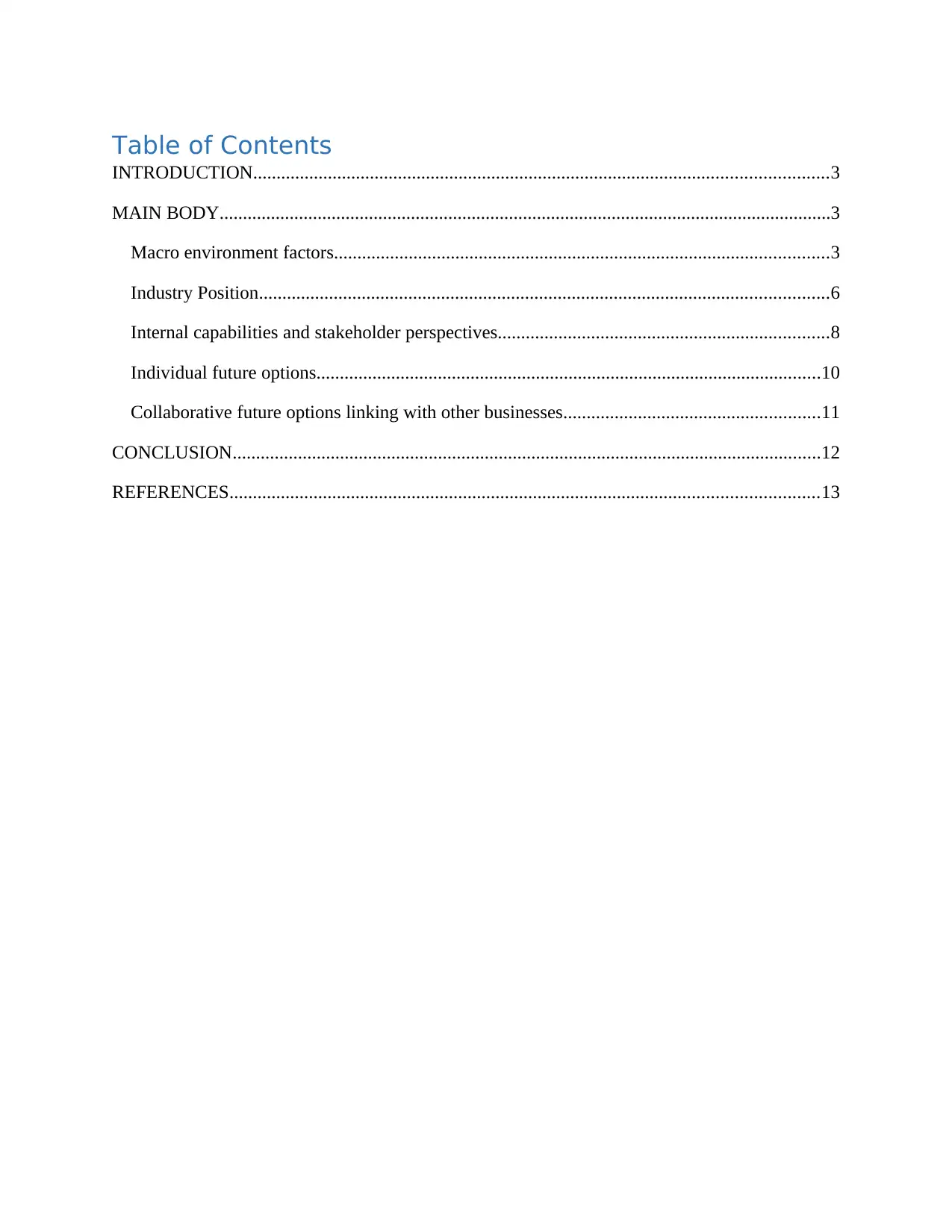
Table of Contents
INTRODUCTION...........................................................................................................................3
MAIN BODY...................................................................................................................................3
Macro environment factors..........................................................................................................3
Industry Position..........................................................................................................................6
Internal capabilities and stakeholder perspectives.......................................................................8
Individual future options............................................................................................................10
Collaborative future options linking with other businesses.......................................................11
CONCLUSION..............................................................................................................................12
REFERENCES..............................................................................................................................13
INTRODUCTION...........................................................................................................................3
MAIN BODY...................................................................................................................................3
Macro environment factors..........................................................................................................3
Industry Position..........................................................................................................................6
Internal capabilities and stakeholder perspectives.......................................................................8
Individual future options............................................................................................................10
Collaborative future options linking with other businesses.......................................................11
CONCLUSION..............................................................................................................................12
REFERENCES..............................................................................................................................13
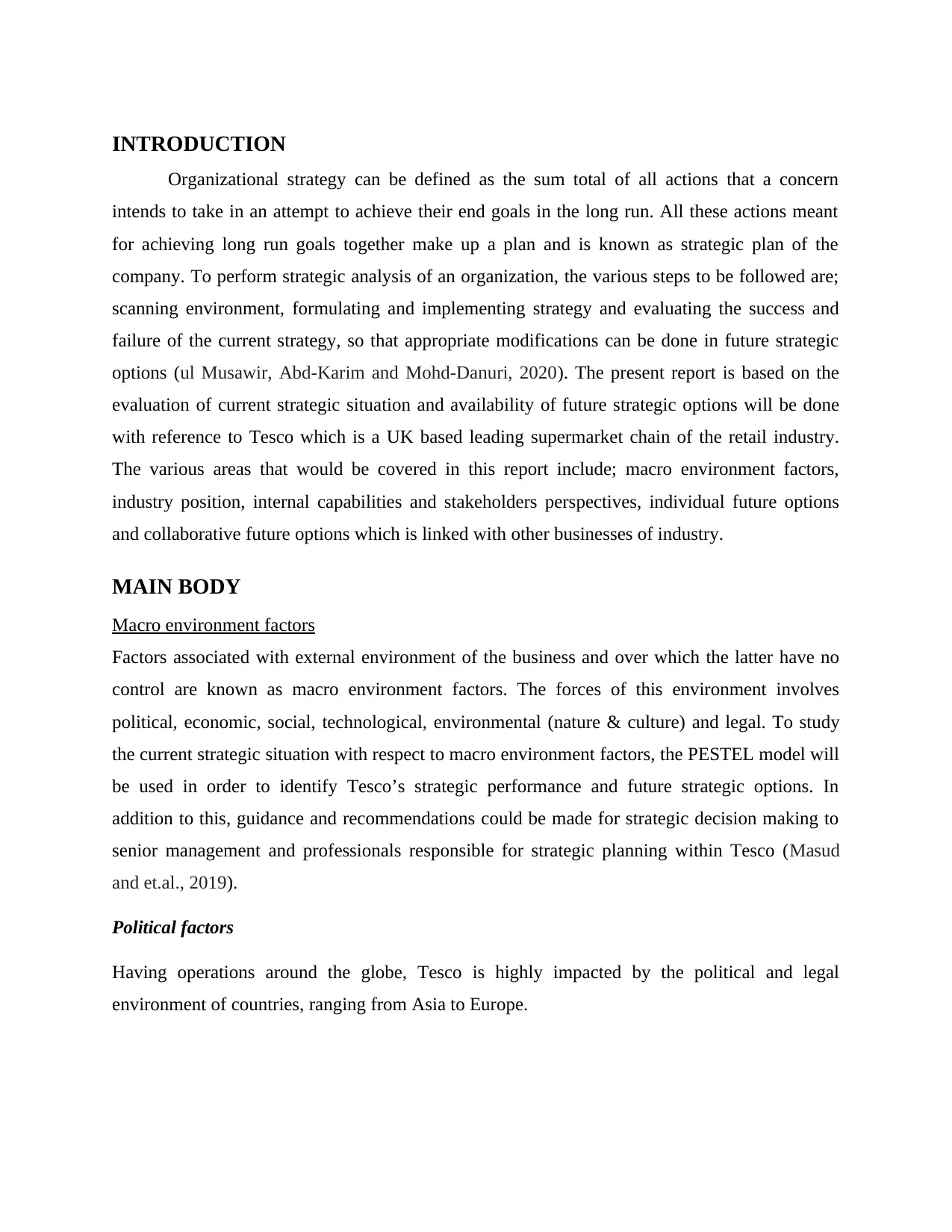
INTRODUCTION
Organizational strategy can be defined as the sum total of all actions that a concern
intends to take in an attempt to achieve their end goals in the long run. All these actions meant
for achieving long run goals together make up a plan and is known as strategic plan of the
company. To perform strategic analysis of an organization, the various steps to be followed are;
scanning environment, formulating and implementing strategy and evaluating the success and
failure of the current strategy, so that appropriate modifications can be done in future strategic
options (ul Musawir, Abd-Karim and Mohd-Danuri, 2020). The present report is based on the
evaluation of current strategic situation and availability of future strategic options will be done
with reference to Tesco which is a UK based leading supermarket chain of the retail industry.
The various areas that would be covered in this report include; macro environment factors,
industry position, internal capabilities and stakeholders perspectives, individual future options
and collaborative future options which is linked with other businesses of industry.
MAIN BODY
Macro environment factors
Factors associated with external environment of the business and over which the latter have no
control are known as macro environment factors. The forces of this environment involves
political, economic, social, technological, environmental (nature & culture) and legal. To study
the current strategic situation with respect to macro environment factors, the PESTEL model will
be used in order to identify Tesco’s strategic performance and future strategic options. In
addition to this, guidance and recommendations could be made for strategic decision making to
senior management and professionals responsible for strategic planning within Tesco (Masud
and et.al., 2019).
Political factors
Having operations around the globe, Tesco is highly impacted by the political and legal
environment of countries, ranging from Asia to Europe.
Organizational strategy can be defined as the sum total of all actions that a concern
intends to take in an attempt to achieve their end goals in the long run. All these actions meant
for achieving long run goals together make up a plan and is known as strategic plan of the
company. To perform strategic analysis of an organization, the various steps to be followed are;
scanning environment, formulating and implementing strategy and evaluating the success and
failure of the current strategy, so that appropriate modifications can be done in future strategic
options (ul Musawir, Abd-Karim and Mohd-Danuri, 2020). The present report is based on the
evaluation of current strategic situation and availability of future strategic options will be done
with reference to Tesco which is a UK based leading supermarket chain of the retail industry.
The various areas that would be covered in this report include; macro environment factors,
industry position, internal capabilities and stakeholders perspectives, individual future options
and collaborative future options which is linked with other businesses of industry.
MAIN BODY
Macro environment factors
Factors associated with external environment of the business and over which the latter have no
control are known as macro environment factors. The forces of this environment involves
political, economic, social, technological, environmental (nature & culture) and legal. To study
the current strategic situation with respect to macro environment factors, the PESTEL model will
be used in order to identify Tesco’s strategic performance and future strategic options. In
addition to this, guidance and recommendations could be made for strategic decision making to
senior management and professionals responsible for strategic planning within Tesco (Masud
and et.al., 2019).
Political factors
Having operations around the globe, Tesco is highly impacted by the political and legal
environment of countries, ranging from Asia to Europe.
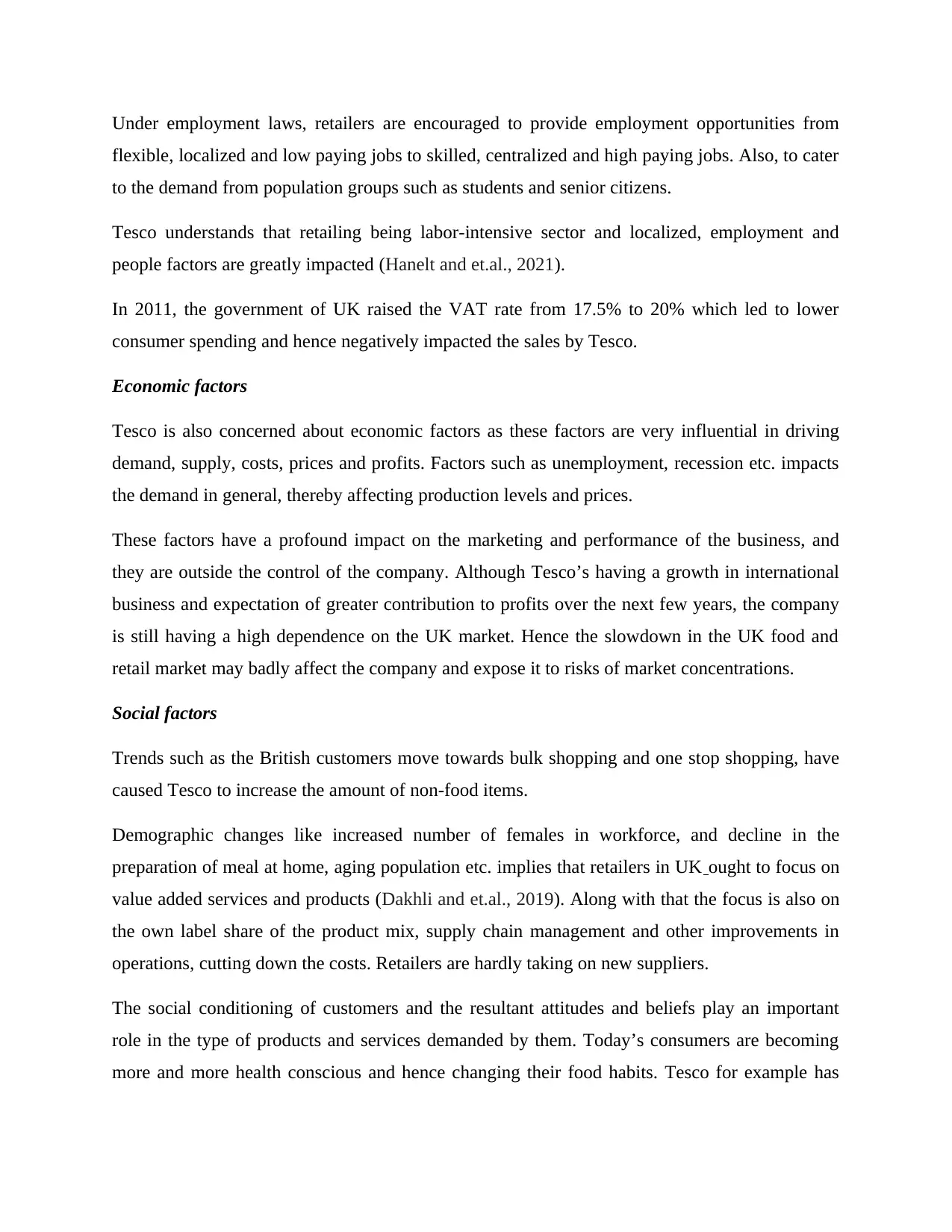
Under employment laws, retailers are encouraged to provide employment opportunities from
flexible, localized and low paying jobs to skilled, centralized and high paying jobs. Also, to cater
to the demand from population groups such as students and senior citizens.
Tesco understands that retailing being labor-intensive sector and localized, employment and
people factors are greatly impacted (Hanelt and et.al., 2021).
In 2011, the government of UK raised the VAT rate from 17.5% to 20% which led to lower
consumer spending and hence negatively impacted the sales by Tesco.
Economic factors
Tesco is also concerned about economic factors as these factors are very influential in driving
demand, supply, costs, prices and profits. Factors such as unemployment, recession etc. impacts
the demand in general, thereby affecting production levels and prices.
These factors have a profound impact on the marketing and performance of the business, and
they are outside the control of the company. Although Tesco’s having a growth in international
business and expectation of greater contribution to profits over the next few years, the company
is still having a high dependence on the UK market. Hence the slowdown in the UK food and
retail market may badly affect the company and expose it to risks of market concentrations.
Social factors
Trends such as the British customers move towards bulk shopping and one stop shopping, have
caused Tesco to increase the amount of non-food items.
Demographic changes like increased number of females in workforce, and decline in the
preparation of meal at home, aging population etc. implies that retailers in UK ought to focus on
value added services and products (Dakhli and et.al., 2019). Along with that the focus is also on
the own label share of the product mix, supply chain management and other improvements in
operations, cutting down the costs. Retailers are hardly taking on new suppliers.
The social conditioning of customers and the resultant attitudes and beliefs play an important
role in the type of products and services demanded by them. Today’s consumers are becoming
more and more health conscious and hence changing their food habits. Tesco for example has
flexible, localized and low paying jobs to skilled, centralized and high paying jobs. Also, to cater
to the demand from population groups such as students and senior citizens.
Tesco understands that retailing being labor-intensive sector and localized, employment and
people factors are greatly impacted (Hanelt and et.al., 2021).
In 2011, the government of UK raised the VAT rate from 17.5% to 20% which led to lower
consumer spending and hence negatively impacted the sales by Tesco.
Economic factors
Tesco is also concerned about economic factors as these factors are very influential in driving
demand, supply, costs, prices and profits. Factors such as unemployment, recession etc. impacts
the demand in general, thereby affecting production levels and prices.
These factors have a profound impact on the marketing and performance of the business, and
they are outside the control of the company. Although Tesco’s having a growth in international
business and expectation of greater contribution to profits over the next few years, the company
is still having a high dependence on the UK market. Hence the slowdown in the UK food and
retail market may badly affect the company and expose it to risks of market concentrations.
Social factors
Trends such as the British customers move towards bulk shopping and one stop shopping, have
caused Tesco to increase the amount of non-food items.
Demographic changes like increased number of females in workforce, and decline in the
preparation of meal at home, aging population etc. implies that retailers in UK ought to focus on
value added services and products (Dakhli and et.al., 2019). Along with that the focus is also on
the own label share of the product mix, supply chain management and other improvements in
operations, cutting down the costs. Retailers are hardly taking on new suppliers.
The social conditioning of customers and the resultant attitudes and beliefs play an important
role in the type of products and services demanded by them. Today’s consumers are becoming
more and more health conscious and hence changing their food habits. Tesco for example has
Paraphrase This Document
Need a fresh take? Get an instant paraphrase of this document with our AI Paraphraser
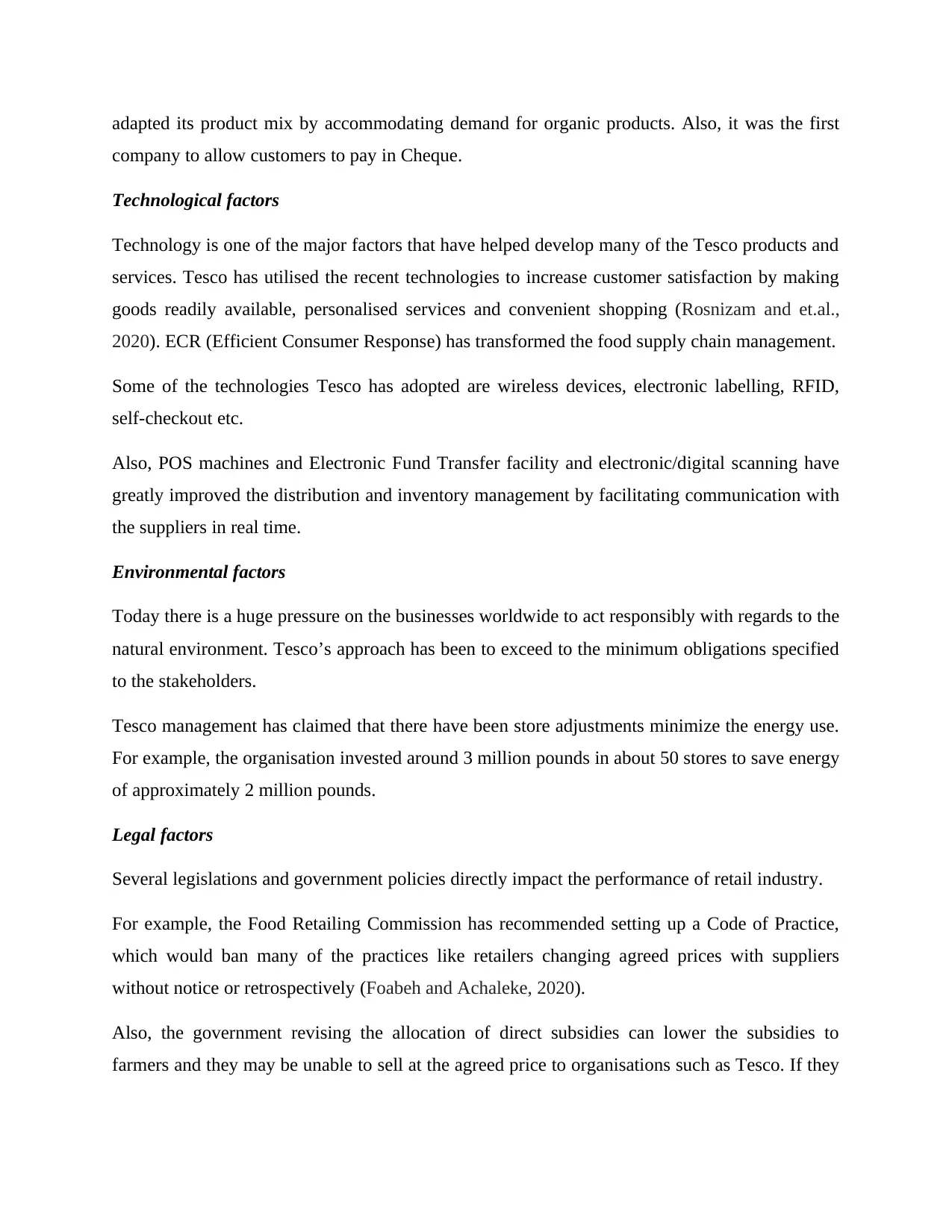
adapted its product mix by accommodating demand for organic products. Also, it was the first
company to allow customers to pay in Cheque.
Technological factors
Technology is one of the major factors that have helped develop many of the Tesco products and
services. Tesco has utilised the recent technologies to increase customer satisfaction by making
goods readily available, personalised services and convenient shopping (Rosnizam and et.al.,
2020). ECR (Efficient Consumer Response) has transformed the food supply chain management.
Some of the technologies Tesco has adopted are wireless devices, electronic labelling, RFID,
self-checkout etc.
Also, POS machines and Electronic Fund Transfer facility and electronic/digital scanning have
greatly improved the distribution and inventory management by facilitating communication with
the suppliers in real time.
Environmental factors
Today there is a huge pressure on the businesses worldwide to act responsibly with regards to the
natural environment. Tesco’s approach has been to exceed to the minimum obligations specified
to the stakeholders.
Tesco management has claimed that there have been store adjustments minimize the energy use.
For example, the organisation invested around 3 million pounds in about 50 stores to save energy
of approximately 2 million pounds.
Legal factors
Several legislations and government policies directly impact the performance of retail industry.
For example, the Food Retailing Commission has recommended setting up a Code of Practice,
which would ban many of the practices like retailers changing agreed prices with suppliers
without notice or retrospectively (Foabeh and Achaleke, 2020).
Also, the government revising the allocation of direct subsidies can lower the subsidies to
farmers and they may be unable to sell at the agreed price to organisations such as Tesco. If they
company to allow customers to pay in Cheque.
Technological factors
Technology is one of the major factors that have helped develop many of the Tesco products and
services. Tesco has utilised the recent technologies to increase customer satisfaction by making
goods readily available, personalised services and convenient shopping (Rosnizam and et.al.,
2020). ECR (Efficient Consumer Response) has transformed the food supply chain management.
Some of the technologies Tesco has adopted are wireless devices, electronic labelling, RFID,
self-checkout etc.
Also, POS machines and Electronic Fund Transfer facility and electronic/digital scanning have
greatly improved the distribution and inventory management by facilitating communication with
the suppliers in real time.
Environmental factors
Today there is a huge pressure on the businesses worldwide to act responsibly with regards to the
natural environment. Tesco’s approach has been to exceed to the minimum obligations specified
to the stakeholders.
Tesco management has claimed that there have been store adjustments minimize the energy use.
For example, the organisation invested around 3 million pounds in about 50 stores to save energy
of approximately 2 million pounds.
Legal factors
Several legislations and government policies directly impact the performance of retail industry.
For example, the Food Retailing Commission has recommended setting up a Code of Practice,
which would ban many of the practices like retailers changing agreed prices with suppliers
without notice or retrospectively (Foabeh and Achaleke, 2020).
Also, the government revising the allocation of direct subsidies can lower the subsidies to
farmers and they may be unable to sell at the agreed price to organisations such as Tesco. If they
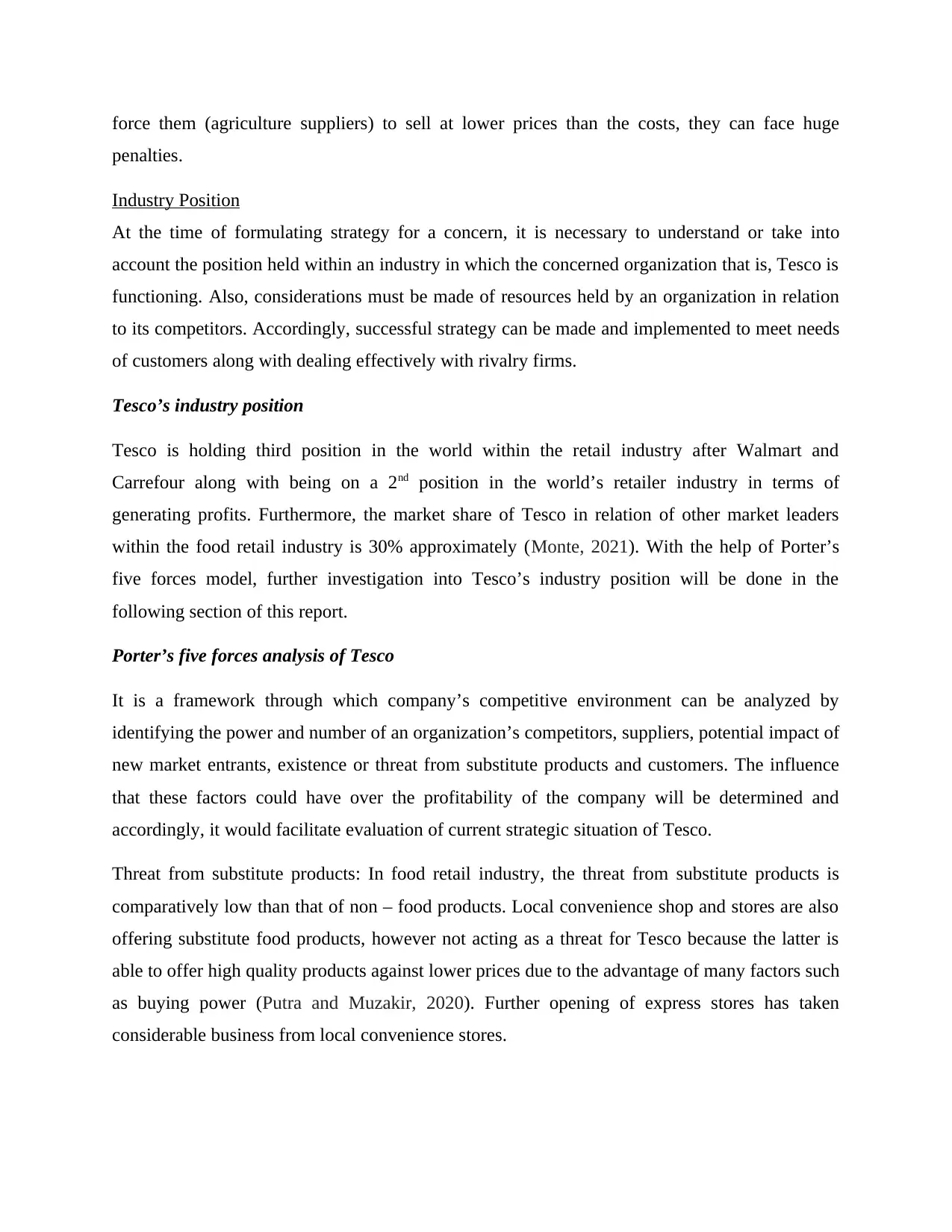
force them (agriculture suppliers) to sell at lower prices than the costs, they can face huge
penalties.
Industry Position
At the time of formulating strategy for a concern, it is necessary to understand or take into
account the position held within an industry in which the concerned organization that is, Tesco is
functioning. Also, considerations must be made of resources held by an organization in relation
to its competitors. Accordingly, successful strategy can be made and implemented to meet needs
of customers along with dealing effectively with rivalry firms.
Tesco’s industry position
Tesco is holding third position in the world within the retail industry after Walmart and
Carrefour along with being on a 2nd position in the world’s retailer industry in terms of
generating profits. Furthermore, the market share of Tesco in relation of other market leaders
within the food retail industry is 30% approximately (Monte, 2021). With the help of Porter’s
five forces model, further investigation into Tesco’s industry position will be done in the
following section of this report.
Porter’s five forces analysis of Tesco
It is a framework through which company’s competitive environment can be analyzed by
identifying the power and number of an organization’s competitors, suppliers, potential impact of
new market entrants, existence or threat from substitute products and customers. The influence
that these factors could have over the profitability of the company will be determined and
accordingly, it would facilitate evaluation of current strategic situation of Tesco.
Threat from substitute products: In food retail industry, the threat from substitute products is
comparatively low than that of non – food products. Local convenience shop and stores are also
offering substitute food products, however not acting as a threat for Tesco because the latter is
able to offer high quality products against lower prices due to the advantage of many factors such
as buying power (Putra and Muzakir, 2020). Further opening of express stores has taken
considerable business from local convenience stores.
penalties.
Industry Position
At the time of formulating strategy for a concern, it is necessary to understand or take into
account the position held within an industry in which the concerned organization that is, Tesco is
functioning. Also, considerations must be made of resources held by an organization in relation
to its competitors. Accordingly, successful strategy can be made and implemented to meet needs
of customers along with dealing effectively with rivalry firms.
Tesco’s industry position
Tesco is holding third position in the world within the retail industry after Walmart and
Carrefour along with being on a 2nd position in the world’s retailer industry in terms of
generating profits. Furthermore, the market share of Tesco in relation of other market leaders
within the food retail industry is 30% approximately (Monte, 2021). With the help of Porter’s
five forces model, further investigation into Tesco’s industry position will be done in the
following section of this report.
Porter’s five forces analysis of Tesco
It is a framework through which company’s competitive environment can be analyzed by
identifying the power and number of an organization’s competitors, suppliers, potential impact of
new market entrants, existence or threat from substitute products and customers. The influence
that these factors could have over the profitability of the company will be determined and
accordingly, it would facilitate evaluation of current strategic situation of Tesco.
Threat from substitute products: In food retail industry, the threat from substitute products is
comparatively low than that of non – food products. Local convenience shop and stores are also
offering substitute food products, however not acting as a threat for Tesco because the latter is
able to offer high quality products against lower prices due to the advantage of many factors such
as buying power (Putra and Muzakir, 2020). Further opening of express stores has taken
considerable business from local convenience stores.
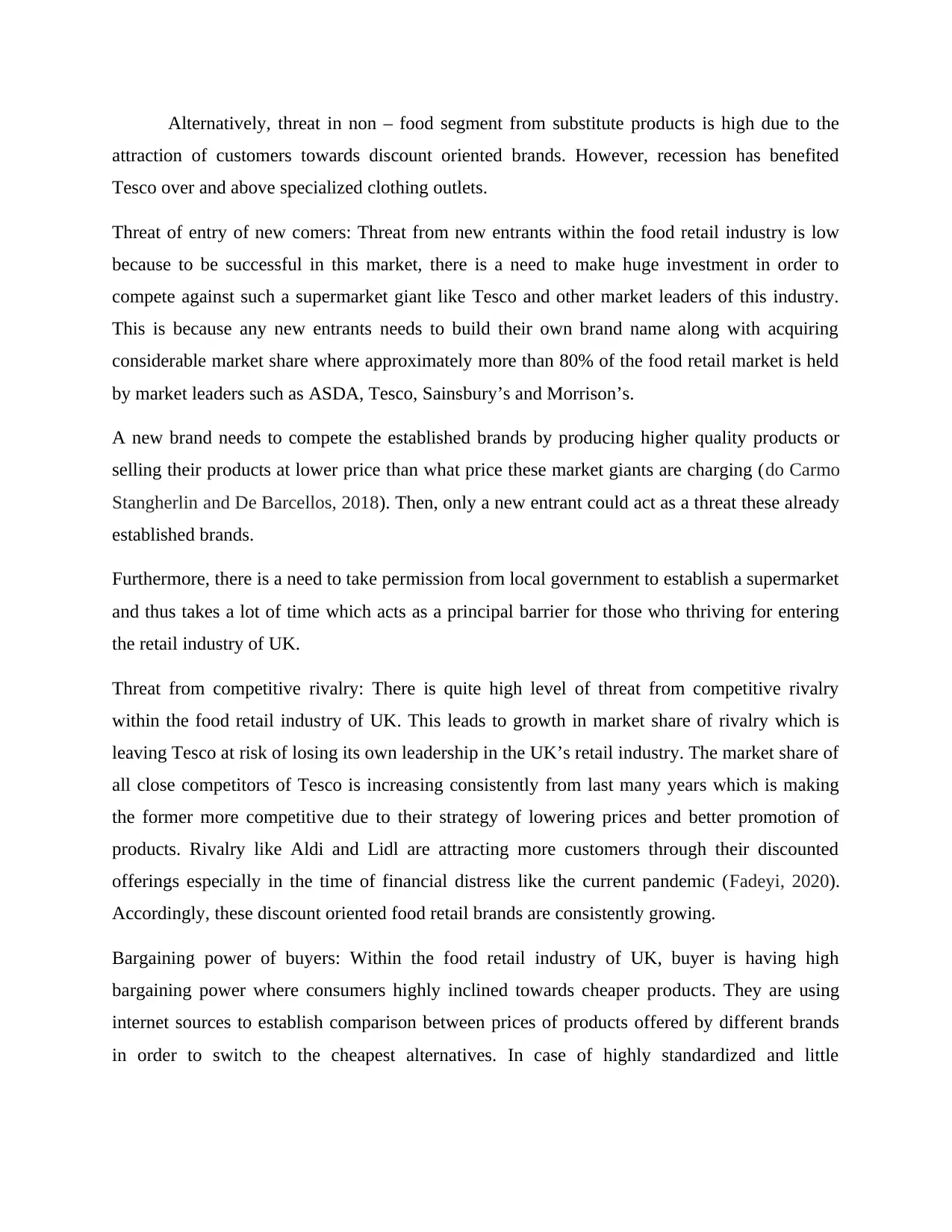
Alternatively, threat in non – food segment from substitute products is high due to the
attraction of customers towards discount oriented brands. However, recession has benefited
Tesco over and above specialized clothing outlets.
Threat of entry of new comers: Threat from new entrants within the food retail industry is low
because to be successful in this market, there is a need to make huge investment in order to
compete against such a supermarket giant like Tesco and other market leaders of this industry.
This is because any new entrants needs to build their own brand name along with acquiring
considerable market share where approximately more than 80% of the food retail market is held
by market leaders such as ASDA, Tesco, Sainsbury’s and Morrison’s.
A new brand needs to compete the established brands by producing higher quality products or
selling their products at lower price than what price these market giants are charging (do Carmo
Stangherlin and De Barcellos, 2018). Then, only a new entrant could act as a threat these already
established brands.
Furthermore, there is a need to take permission from local government to establish a supermarket
and thus takes a lot of time which acts as a principal barrier for those who thriving for entering
the retail industry of UK.
Threat from competitive rivalry: There is quite high level of threat from competitive rivalry
within the food retail industry of UK. This leads to growth in market share of rivalry which is
leaving Tesco at risk of losing its own leadership in the UK’s retail industry. The market share of
all close competitors of Tesco is increasing consistently from last many years which is making
the former more competitive due to their strategy of lowering prices and better promotion of
products. Rivalry like Aldi and Lidl are attracting more customers through their discounted
offerings especially in the time of financial distress like the current pandemic (Fadeyi, 2020).
Accordingly, these discount oriented food retail brands are consistently growing.
Bargaining power of buyers: Within the food retail industry of UK, buyer is having high
bargaining power where consumers highly inclined towards cheaper products. They are using
internet sources to establish comparison between prices of products offered by different brands
in order to switch to the cheapest alternatives. In case of highly standardized and little
attraction of customers towards discount oriented brands. However, recession has benefited
Tesco over and above specialized clothing outlets.
Threat of entry of new comers: Threat from new entrants within the food retail industry is low
because to be successful in this market, there is a need to make huge investment in order to
compete against such a supermarket giant like Tesco and other market leaders of this industry.
This is because any new entrants needs to build their own brand name along with acquiring
considerable market share where approximately more than 80% of the food retail market is held
by market leaders such as ASDA, Tesco, Sainsbury’s and Morrison’s.
A new brand needs to compete the established brands by producing higher quality products or
selling their products at lower price than what price these market giants are charging (do Carmo
Stangherlin and De Barcellos, 2018). Then, only a new entrant could act as a threat these already
established brands.
Furthermore, there is a need to take permission from local government to establish a supermarket
and thus takes a lot of time which acts as a principal barrier for those who thriving for entering
the retail industry of UK.
Threat from competitive rivalry: There is quite high level of threat from competitive rivalry
within the food retail industry of UK. This leads to growth in market share of rivalry which is
leaving Tesco at risk of losing its own leadership in the UK’s retail industry. The market share of
all close competitors of Tesco is increasing consistently from last many years which is making
the former more competitive due to their strategy of lowering prices and better promotion of
products. Rivalry like Aldi and Lidl are attracting more customers through their discounted
offerings especially in the time of financial distress like the current pandemic (Fadeyi, 2020).
Accordingly, these discount oriented food retail brands are consistently growing.
Bargaining power of buyers: Within the food retail industry of UK, buyer is having high
bargaining power where consumers highly inclined towards cheaper products. They are using
internet sources to establish comparison between prices of products offered by different brands
in order to switch to the cheapest alternatives. In case of highly standardized and little
Secure Best Marks with AI Grader
Need help grading? Try our AI Grader for instant feedback on your assignments.
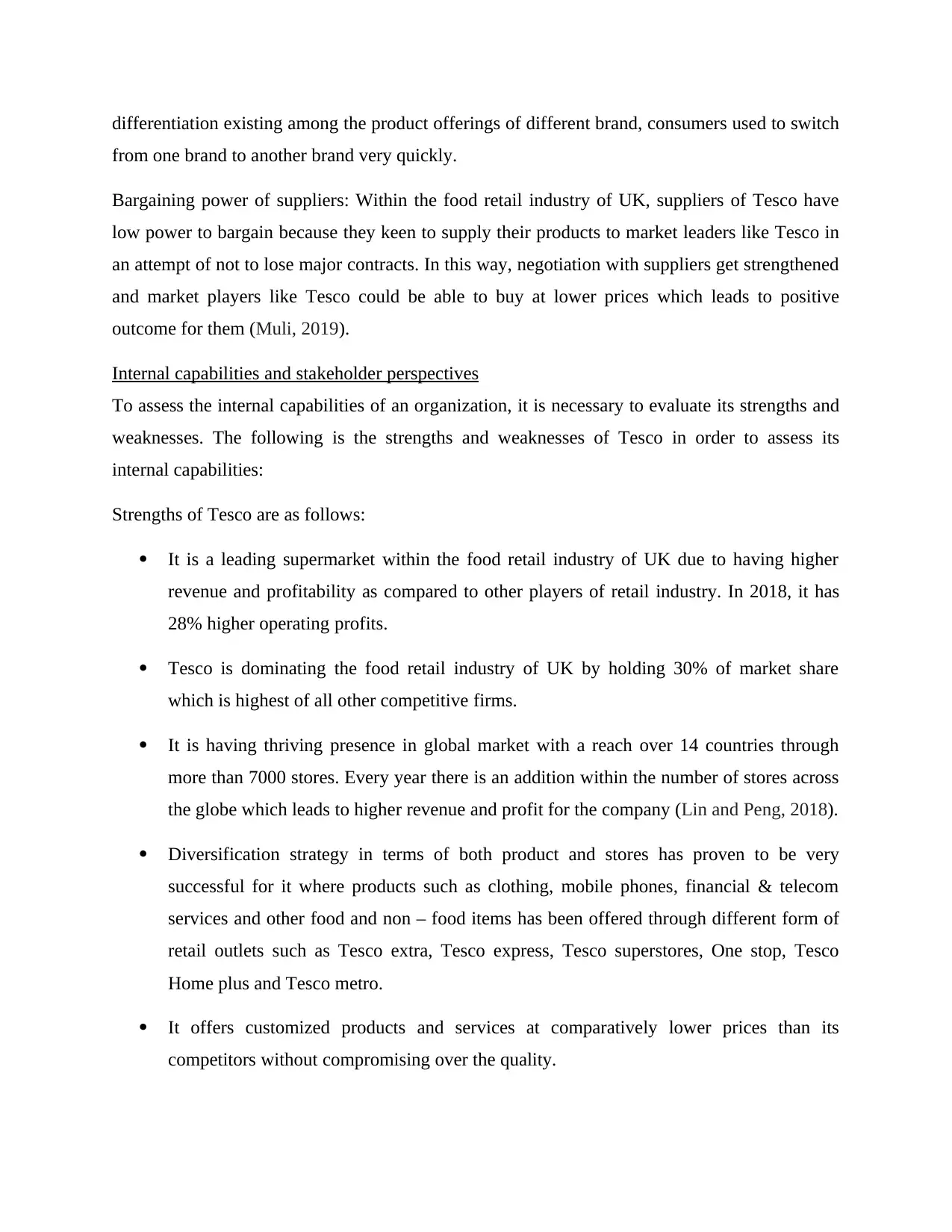
differentiation existing among the product offerings of different brand, consumers used to switch
from one brand to another brand very quickly.
Bargaining power of suppliers: Within the food retail industry of UK, suppliers of Tesco have
low power to bargain because they keen to supply their products to market leaders like Tesco in
an attempt of not to lose major contracts. In this way, negotiation with suppliers get strengthened
and market players like Tesco could be able to buy at lower prices which leads to positive
outcome for them (Muli, 2019).
Internal capabilities and stakeholder perspectives
To assess the internal capabilities of an organization, it is necessary to evaluate its strengths and
weaknesses. The following is the strengths and weaknesses of Tesco in order to assess its
internal capabilities:
Strengths of Tesco are as follows:
It is a leading supermarket within the food retail industry of UK due to having higher
revenue and profitability as compared to other players of retail industry. In 2018, it has
28% higher operating profits.
Tesco is dominating the food retail industry of UK by holding 30% of market share
which is highest of all other competitive firms.
It is having thriving presence in global market with a reach over 14 countries through
more than 7000 stores. Every year there is an addition within the number of stores across
the globe which leads to higher revenue and profit for the company (Lin and Peng, 2018).
Diversification strategy in terms of both product and stores has proven to be very
successful for it where products such as clothing, mobile phones, financial & telecom
services and other food and non – food items has been offered through different form of
retail outlets such as Tesco extra, Tesco express, Tesco superstores, One stop, Tesco
Home plus and Tesco metro.
It offers customized products and services at comparatively lower prices than its
competitors without compromising over the quality.
from one brand to another brand very quickly.
Bargaining power of suppliers: Within the food retail industry of UK, suppliers of Tesco have
low power to bargain because they keen to supply their products to market leaders like Tesco in
an attempt of not to lose major contracts. In this way, negotiation with suppliers get strengthened
and market players like Tesco could be able to buy at lower prices which leads to positive
outcome for them (Muli, 2019).
Internal capabilities and stakeholder perspectives
To assess the internal capabilities of an organization, it is necessary to evaluate its strengths and
weaknesses. The following is the strengths and weaknesses of Tesco in order to assess its
internal capabilities:
Strengths of Tesco are as follows:
It is a leading supermarket within the food retail industry of UK due to having higher
revenue and profitability as compared to other players of retail industry. In 2018, it has
28% higher operating profits.
Tesco is dominating the food retail industry of UK by holding 30% of market share
which is highest of all other competitive firms.
It is having thriving presence in global market with a reach over 14 countries through
more than 7000 stores. Every year there is an addition within the number of stores across
the globe which leads to higher revenue and profit for the company (Lin and Peng, 2018).
Diversification strategy in terms of both product and stores has proven to be very
successful for it where products such as clothing, mobile phones, financial & telecom
services and other food and non – food items has been offered through different form of
retail outlets such as Tesco extra, Tesco express, Tesco superstores, One stop, Tesco
Home plus and Tesco metro.
It offers customized products and services at comparatively lower prices than its
competitors without compromising over the quality.
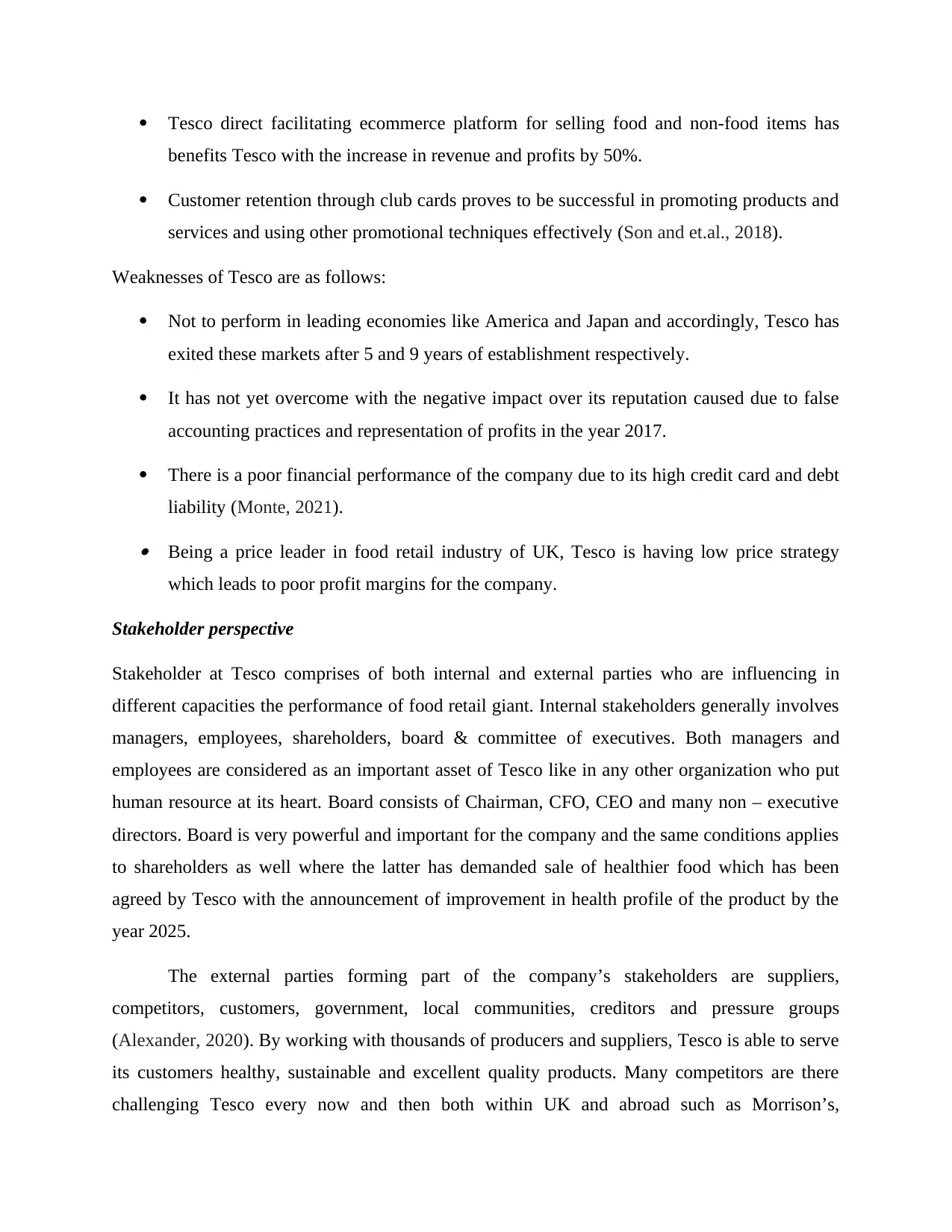
Tesco direct facilitating ecommerce platform for selling food and non-food items has
benefits Tesco with the increase in revenue and profits by 50%.
Customer retention through club cards proves to be successful in promoting products and
services and using other promotional techniques effectively (Son and et.al., 2018).
Weaknesses of Tesco are as follows:
Not to perform in leading economies like America and Japan and accordingly, Tesco has
exited these markets after 5 and 9 years of establishment respectively.
It has not yet overcome with the negative impact over its reputation caused due to false
accounting practices and representation of profits in the year 2017.
There is a poor financial performance of the company due to its high credit card and debt
liability (Monte, 2021). Being a price leader in food retail industry of UK, Tesco is having low price strategy
which leads to poor profit margins for the company.
Stakeholder perspective
Stakeholder at Tesco comprises of both internal and external parties who are influencing in
different capacities the performance of food retail giant. Internal stakeholders generally involves
managers, employees, shareholders, board & committee of executives. Both managers and
employees are considered as an important asset of Tesco like in any other organization who put
human resource at its heart. Board consists of Chairman, CFO, CEO and many non – executive
directors. Board is very powerful and important for the company and the same conditions applies
to shareholders as well where the latter has demanded sale of healthier food which has been
agreed by Tesco with the announcement of improvement in health profile of the product by the
year 2025.
The external parties forming part of the company’s stakeholders are suppliers,
competitors, customers, government, local communities, creditors and pressure groups
(Alexander, 2020). By working with thousands of producers and suppliers, Tesco is able to serve
its customers healthy, sustainable and excellent quality products. Many competitors are there
challenging Tesco every now and then both within UK and abroad such as Morrison’s,
benefits Tesco with the increase in revenue and profits by 50%.
Customer retention through club cards proves to be successful in promoting products and
services and using other promotional techniques effectively (Son and et.al., 2018).
Weaknesses of Tesco are as follows:
Not to perform in leading economies like America and Japan and accordingly, Tesco has
exited these markets after 5 and 9 years of establishment respectively.
It has not yet overcome with the negative impact over its reputation caused due to false
accounting practices and representation of profits in the year 2017.
There is a poor financial performance of the company due to its high credit card and debt
liability (Monte, 2021). Being a price leader in food retail industry of UK, Tesco is having low price strategy
which leads to poor profit margins for the company.
Stakeholder perspective
Stakeholder at Tesco comprises of both internal and external parties who are influencing in
different capacities the performance of food retail giant. Internal stakeholders generally involves
managers, employees, shareholders, board & committee of executives. Both managers and
employees are considered as an important asset of Tesco like in any other organization who put
human resource at its heart. Board consists of Chairman, CFO, CEO and many non – executive
directors. Board is very powerful and important for the company and the same conditions applies
to shareholders as well where the latter has demanded sale of healthier food which has been
agreed by Tesco with the announcement of improvement in health profile of the product by the
year 2025.
The external parties forming part of the company’s stakeholders are suppliers,
competitors, customers, government, local communities, creditors and pressure groups
(Alexander, 2020). By working with thousands of producers and suppliers, Tesco is able to serve
its customers healthy, sustainable and excellent quality products. Many competitors are there
challenging Tesco every now and then both within UK and abroad such as Morrison’s,
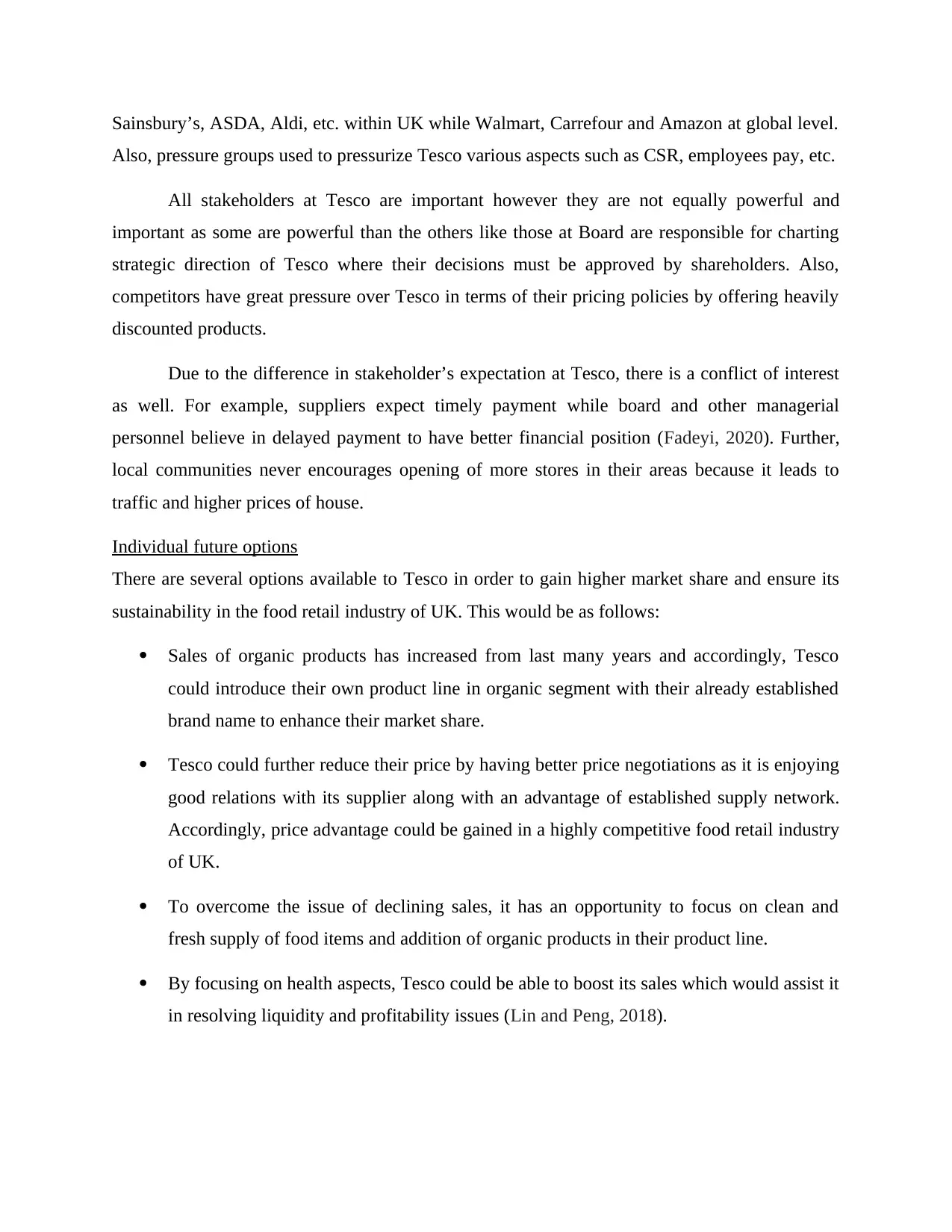
Sainsbury’s, ASDA, Aldi, etc. within UK while Walmart, Carrefour and Amazon at global level.
Also, pressure groups used to pressurize Tesco various aspects such as CSR, employees pay, etc.
All stakeholders at Tesco are important however they are not equally powerful and
important as some are powerful than the others like those at Board are responsible for charting
strategic direction of Tesco where their decisions must be approved by shareholders. Also,
competitors have great pressure over Tesco in terms of their pricing policies by offering heavily
discounted products.
Due to the difference in stakeholder’s expectation at Tesco, there is a conflict of interest
as well. For example, suppliers expect timely payment while board and other managerial
personnel believe in delayed payment to have better financial position (Fadeyi, 2020). Further,
local communities never encourages opening of more stores in their areas because it leads to
traffic and higher prices of house.
Individual future options
There are several options available to Tesco in order to gain higher market share and ensure its
sustainability in the food retail industry of UK. This would be as follows:
Sales of organic products has increased from last many years and accordingly, Tesco
could introduce their own product line in organic segment with their already established
brand name to enhance their market share.
Tesco could further reduce their price by having better price negotiations as it is enjoying
good relations with its supplier along with an advantage of established supply network.
Accordingly, price advantage could be gained in a highly competitive food retail industry
of UK.
To overcome the issue of declining sales, it has an opportunity to focus on clean and
fresh supply of food items and addition of organic products in their product line.
By focusing on health aspects, Tesco could be able to boost its sales which would assist it
in resolving liquidity and profitability issues (Lin and Peng, 2018).
Also, pressure groups used to pressurize Tesco various aspects such as CSR, employees pay, etc.
All stakeholders at Tesco are important however they are not equally powerful and
important as some are powerful than the others like those at Board are responsible for charting
strategic direction of Tesco where their decisions must be approved by shareholders. Also,
competitors have great pressure over Tesco in terms of their pricing policies by offering heavily
discounted products.
Due to the difference in stakeholder’s expectation at Tesco, there is a conflict of interest
as well. For example, suppliers expect timely payment while board and other managerial
personnel believe in delayed payment to have better financial position (Fadeyi, 2020). Further,
local communities never encourages opening of more stores in their areas because it leads to
traffic and higher prices of house.
Individual future options
There are several options available to Tesco in order to gain higher market share and ensure its
sustainability in the food retail industry of UK. This would be as follows:
Sales of organic products has increased from last many years and accordingly, Tesco
could introduce their own product line in organic segment with their already established
brand name to enhance their market share.
Tesco could further reduce their price by having better price negotiations as it is enjoying
good relations with its supplier along with an advantage of established supply network.
Accordingly, price advantage could be gained in a highly competitive food retail industry
of UK.
To overcome the issue of declining sales, it has an opportunity to focus on clean and
fresh supply of food items and addition of organic products in their product line.
By focusing on health aspects, Tesco could be able to boost its sales which would assist it
in resolving liquidity and profitability issues (Lin and Peng, 2018).
Paraphrase This Document
Need a fresh take? Get an instant paraphrase of this document with our AI Paraphraser
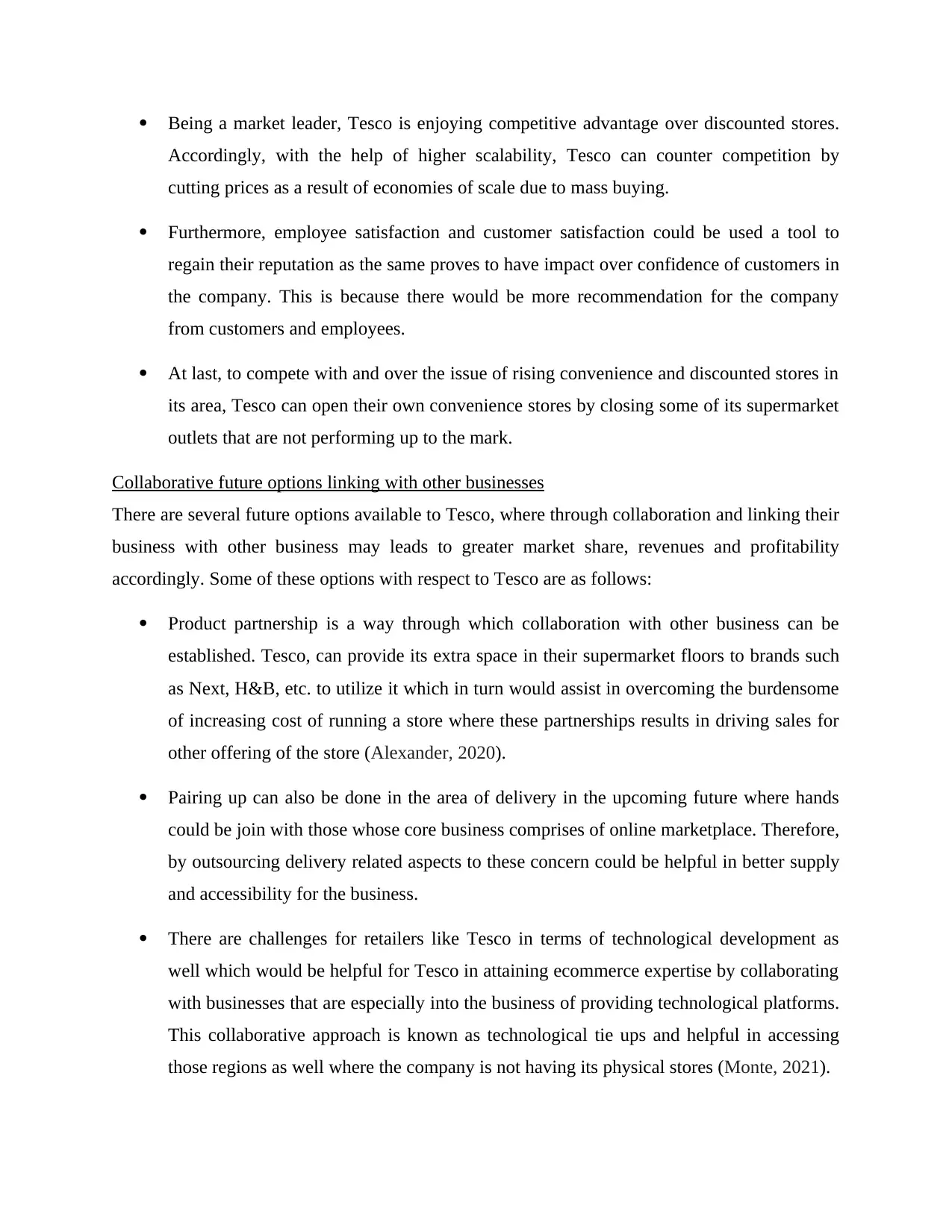
Being a market leader, Tesco is enjoying competitive advantage over discounted stores.
Accordingly, with the help of higher scalability, Tesco can counter competition by
cutting prices as a result of economies of scale due to mass buying.
Furthermore, employee satisfaction and customer satisfaction could be used a tool to
regain their reputation as the same proves to have impact over confidence of customers in
the company. This is because there would be more recommendation for the company
from customers and employees.
At last, to compete with and over the issue of rising convenience and discounted stores in
its area, Tesco can open their own convenience stores by closing some of its supermarket
outlets that are not performing up to the mark.
Collaborative future options linking with other businesses
There are several future options available to Tesco, where through collaboration and linking their
business with other business may leads to greater market share, revenues and profitability
accordingly. Some of these options with respect to Tesco are as follows:
Product partnership is a way through which collaboration with other business can be
established. Tesco, can provide its extra space in their supermarket floors to brands such
as Next, H&B, etc. to utilize it which in turn would assist in overcoming the burdensome
of increasing cost of running a store where these partnerships results in driving sales for
other offering of the store (Alexander, 2020).
Pairing up can also be done in the area of delivery in the upcoming future where hands
could be join with those whose core business comprises of online marketplace. Therefore,
by outsourcing delivery related aspects to these concern could be helpful in better supply
and accessibility for the business.
There are challenges for retailers like Tesco in terms of technological development as
well which would be helpful for Tesco in attaining ecommerce expertise by collaborating
with businesses that are especially into the business of providing technological platforms.
This collaborative approach is known as technological tie ups and helpful in accessing
those regions as well where the company is not having its physical stores (Monte, 2021).
Accordingly, with the help of higher scalability, Tesco can counter competition by
cutting prices as a result of economies of scale due to mass buying.
Furthermore, employee satisfaction and customer satisfaction could be used a tool to
regain their reputation as the same proves to have impact over confidence of customers in
the company. This is because there would be more recommendation for the company
from customers and employees.
At last, to compete with and over the issue of rising convenience and discounted stores in
its area, Tesco can open their own convenience stores by closing some of its supermarket
outlets that are not performing up to the mark.
Collaborative future options linking with other businesses
There are several future options available to Tesco, where through collaboration and linking their
business with other business may leads to greater market share, revenues and profitability
accordingly. Some of these options with respect to Tesco are as follows:
Product partnership is a way through which collaboration with other business can be
established. Tesco, can provide its extra space in their supermarket floors to brands such
as Next, H&B, etc. to utilize it which in turn would assist in overcoming the burdensome
of increasing cost of running a store where these partnerships results in driving sales for
other offering of the store (Alexander, 2020).
Pairing up can also be done in the area of delivery in the upcoming future where hands
could be join with those whose core business comprises of online marketplace. Therefore,
by outsourcing delivery related aspects to these concern could be helpful in better supply
and accessibility for the business.
There are challenges for retailers like Tesco in terms of technological development as
well which would be helpful for Tesco in attaining ecommerce expertise by collaborating
with businesses that are especially into the business of providing technological platforms.
This collaborative approach is known as technological tie ups and helpful in accessing
those regions as well where the company is not having its physical stores (Monte, 2021).
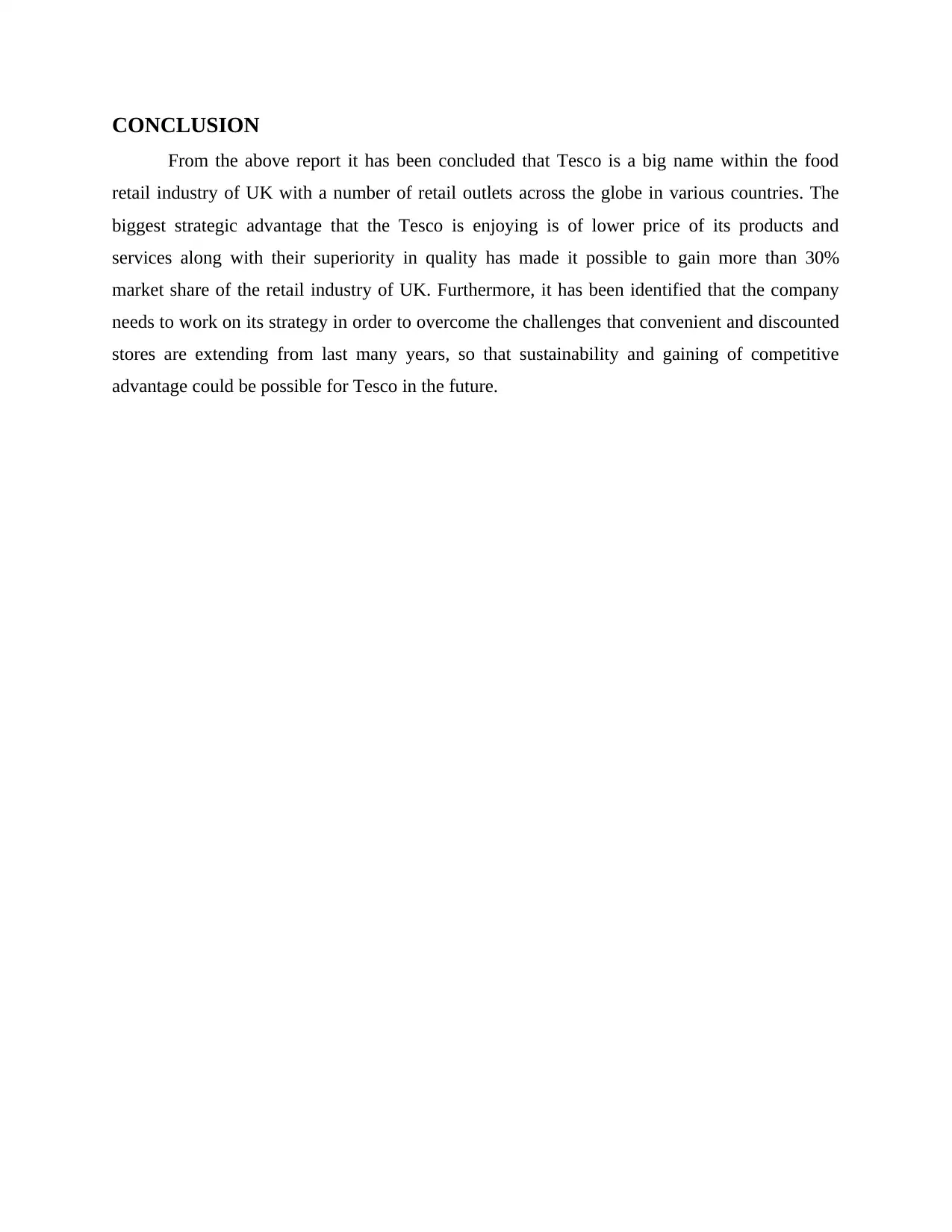
CONCLUSION
From the above report it has been concluded that Tesco is a big name within the food
retail industry of UK with a number of retail outlets across the globe in various countries. The
biggest strategic advantage that the Tesco is enjoying is of lower price of its products and
services along with their superiority in quality has made it possible to gain more than 30%
market share of the retail industry of UK. Furthermore, it has been identified that the company
needs to work on its strategy in order to overcome the challenges that convenient and discounted
stores are extending from last many years, so that sustainability and gaining of competitive
advantage could be possible for Tesco in the future.
From the above report it has been concluded that Tesco is a big name within the food
retail industry of UK with a number of retail outlets across the globe in various countries. The
biggest strategic advantage that the Tesco is enjoying is of lower price of its products and
services along with their superiority in quality has made it possible to gain more than 30%
market share of the retail industry of UK. Furthermore, it has been identified that the company
needs to work on its strategy in order to overcome the challenges that convenient and discounted
stores are extending from last many years, so that sustainability and gaining of competitive
advantage could be possible for Tesco in the future.
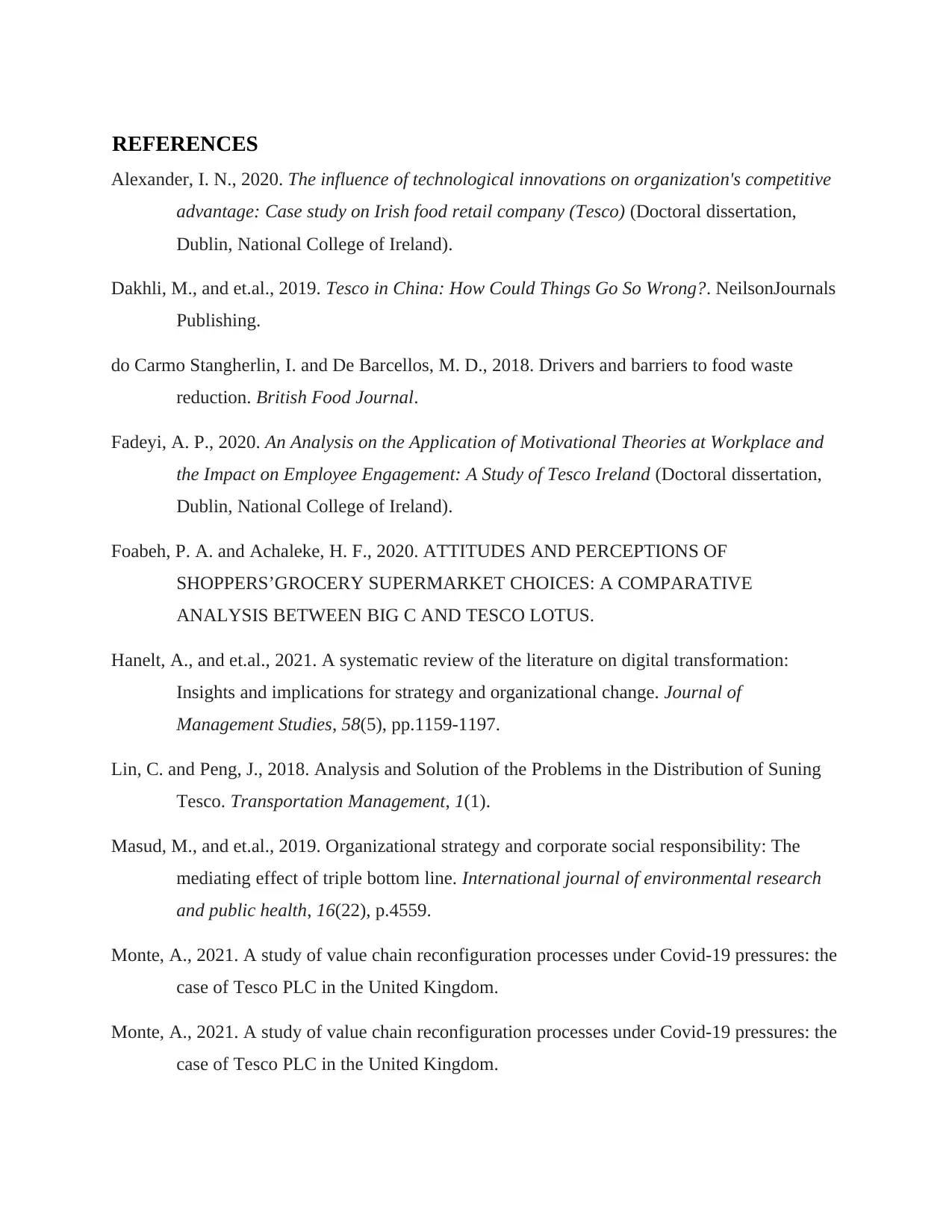
REFERENCES
Alexander, I. N., 2020. The influence of technological innovations on organization's competitive
advantage: Case study on Irish food retail company (Tesco) (Doctoral dissertation,
Dublin, National College of Ireland).
Dakhli, M., and et.al., 2019. Tesco in China: How Could Things Go So Wrong?. NeilsonJournals
Publishing.
do Carmo Stangherlin, I. and De Barcellos, M. D., 2018. Drivers and barriers to food waste
reduction. British Food Journal.
Fadeyi, A. P., 2020. An Analysis on the Application of Motivational Theories at Workplace and
the Impact on Employee Engagement: A Study of Tesco Ireland (Doctoral dissertation,
Dublin, National College of Ireland).
Foabeh, P. A. and Achaleke, H. F., 2020. ATTITUDES AND PERCEPTIONS OF
SHOPPERS’GROCERY SUPERMARKET CHOICES: A COMPARATIVE
ANALYSIS BETWEEN BIG C AND TESCO LOTUS.
Hanelt, A., and et.al., 2021. A systematic review of the literature on digital transformation:
Insights and implications for strategy and organizational change. Journal of
Management Studies, 58(5), pp.1159-1197.
Lin, C. and Peng, J., 2018. Analysis and Solution of the Problems in the Distribution of Suning
Tesco. Transportation Management, 1(1).
Masud, M., and et.al., 2019. Organizational strategy and corporate social responsibility: The
mediating effect of triple bottom line. International journal of environmental research
and public health, 16(22), p.4559.
Monte, A., 2021. A study of value chain reconfiguration processes under Covid-19 pressures: the
case of Tesco PLC in the United Kingdom.
Monte, A., 2021. A study of value chain reconfiguration processes under Covid-19 pressures: the
case of Tesco PLC in the United Kingdom.
Alexander, I. N., 2020. The influence of technological innovations on organization's competitive
advantage: Case study on Irish food retail company (Tesco) (Doctoral dissertation,
Dublin, National College of Ireland).
Dakhli, M., and et.al., 2019. Tesco in China: How Could Things Go So Wrong?. NeilsonJournals
Publishing.
do Carmo Stangherlin, I. and De Barcellos, M. D., 2018. Drivers and barriers to food waste
reduction. British Food Journal.
Fadeyi, A. P., 2020. An Analysis on the Application of Motivational Theories at Workplace and
the Impact on Employee Engagement: A Study of Tesco Ireland (Doctoral dissertation,
Dublin, National College of Ireland).
Foabeh, P. A. and Achaleke, H. F., 2020. ATTITUDES AND PERCEPTIONS OF
SHOPPERS’GROCERY SUPERMARKET CHOICES: A COMPARATIVE
ANALYSIS BETWEEN BIG C AND TESCO LOTUS.
Hanelt, A., and et.al., 2021. A systematic review of the literature on digital transformation:
Insights and implications for strategy and organizational change. Journal of
Management Studies, 58(5), pp.1159-1197.
Lin, C. and Peng, J., 2018. Analysis and Solution of the Problems in the Distribution of Suning
Tesco. Transportation Management, 1(1).
Masud, M., and et.al., 2019. Organizational strategy and corporate social responsibility: The
mediating effect of triple bottom line. International journal of environmental research
and public health, 16(22), p.4559.
Monte, A., 2021. A study of value chain reconfiguration processes under Covid-19 pressures: the
case of Tesco PLC in the United Kingdom.
Monte, A., 2021. A study of value chain reconfiguration processes under Covid-19 pressures: the
case of Tesco PLC in the United Kingdom.
Secure Best Marks with AI Grader
Need help grading? Try our AI Grader for instant feedback on your assignments.
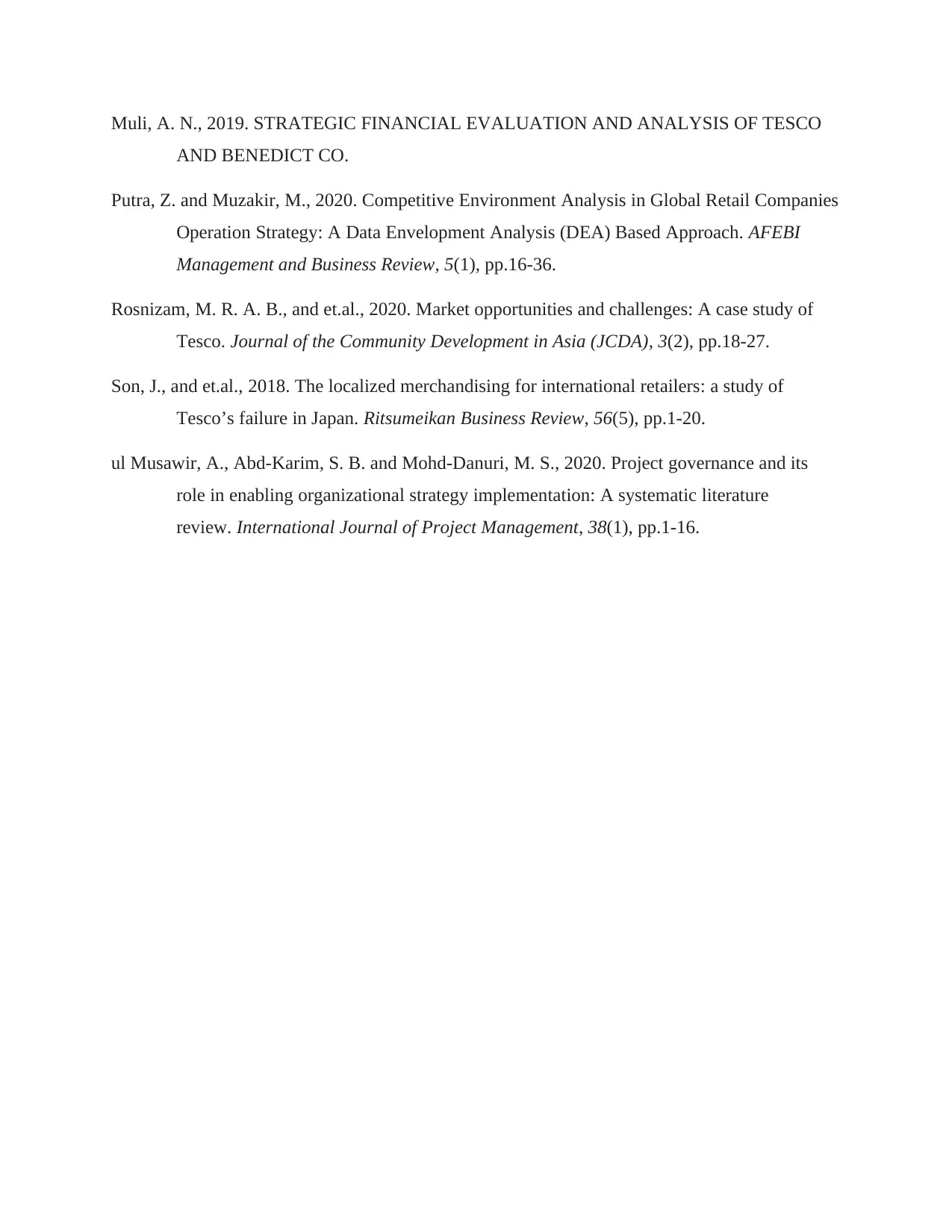
Muli, A. N., 2019. STRATEGIC FINANCIAL EVALUATION AND ANALYSIS OF TESCO
AND BENEDICT CO.
Putra, Z. and Muzakir, M., 2020. Competitive Environment Analysis in Global Retail Companies
Operation Strategy: A Data Envelopment Analysis (DEA) Based Approach. AFEBI
Management and Business Review, 5(1), pp.16-36.
Rosnizam, M. R. A. B., and et.al., 2020. Market opportunities and challenges: A case study of
Tesco. Journal of the Community Development in Asia (JCDA), 3(2), pp.18-27.
Son, J., and et.al., 2018. The localized merchandising for international retailers: a study of
Tesco’s failure in Japan. Ritsumeikan Business Review, 56(5), pp.1-20.
ul Musawir, A., Abd-Karim, S. B. and Mohd-Danuri, M. S., 2020. Project governance and its
role in enabling organizational strategy implementation: A systematic literature
review. International Journal of Project Management, 38(1), pp.1-16.
AND BENEDICT CO.
Putra, Z. and Muzakir, M., 2020. Competitive Environment Analysis in Global Retail Companies
Operation Strategy: A Data Envelopment Analysis (DEA) Based Approach. AFEBI
Management and Business Review, 5(1), pp.16-36.
Rosnizam, M. R. A. B., and et.al., 2020. Market opportunities and challenges: A case study of
Tesco. Journal of the Community Development in Asia (JCDA), 3(2), pp.18-27.
Son, J., and et.al., 2018. The localized merchandising for international retailers: a study of
Tesco’s failure in Japan. Ritsumeikan Business Review, 56(5), pp.1-20.
ul Musawir, A., Abd-Karim, S. B. and Mohd-Danuri, M. S., 2020. Project governance and its
role in enabling organizational strategy implementation: A systematic literature
review. International Journal of Project Management, 38(1), pp.1-16.
1 out of 14
![[object Object]](/_next/static/media/star-bottom.7253800d.svg)





